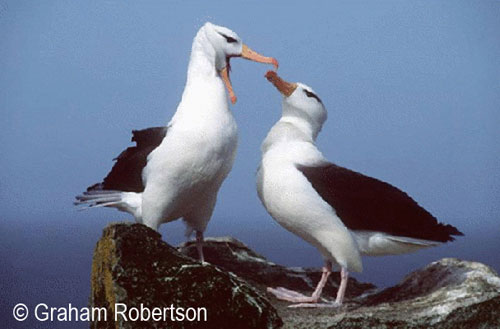Marie Nevoux and colleagues based at the Centre d'Etude Biologiques de Chizé in France have recently published in the journal Oecologia on whether environmental conditions during breeding effect recruitment of Black-browed Albatrosses Thalassarche melanophris at the Kerguelen Islands.
The paper's abstract follows:
"Short-term effects of environmental perturbations on various life history traits are reasonably well documented in birds and mammals. But, in the present context of global climate change, there is a need to consider potential long-term effects of natal conditions to better understand and predict the consequences of these changes on population dynamics. The environmental conditions affecting offspring during their early development may determine their lifetime reproductive performance, and therefore the number of recruits produced by a cohort. In this study, we attempted to link recruitment to natal and recent (previous year) conditions in the long-lived Black-browed Albatross Thalassarche melanophris at Kerguelen Islands. The environmental variability was described using both climatic variables over breeding (sea surface temperature anomaly) and non-breeding grounds (Southern Oscillation index), and variables related to the colony (breeding success and colony size). Immature survival was linked to the breeding success of the colony in the year of birth, which was expected to reflect the average seasonal parental investment. At the cohort level, this initial mortality event may act as a selective filter shaping the number, and presumably the quality (breeding frequency, breeding success probability), of the individuals that recruit into the breeding population. The decision to start breeding was strongly structured by the age of the individuals and adjusted according to recent conditions. An effect of natal conditions was not detected on this parameter, supporting the selection hypothesis. Recruitment, as a whole, was thus influenced by a combination of long- and short-term environmental impacts. Our results highlight the complexity of the influence of environmental factors on such long-lived species, due to the time-lag (associated with a delayed maturity) between the impact of natal conditions on individuals and their repercussion on the breeding population."

Reference:
Nevoux, M., Weimerskirch, H. & Barbraud, C. 2010. Long- and short-term influence of environment on recruitment in a species with highly delayed maturity. Oecologia 162:383-392. http://www.springerlink.com/content/65745753l8315t3k/fulltext.pdf.
John Cooper, ACAP Information Officer, 31 October 2010

 Français
Français  English
English  Español
Español